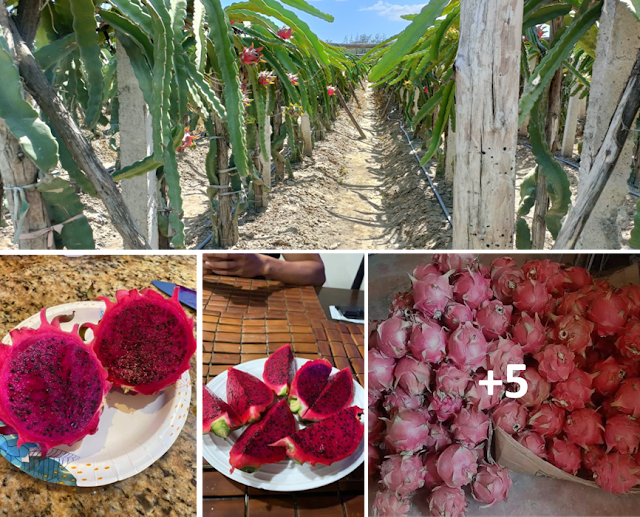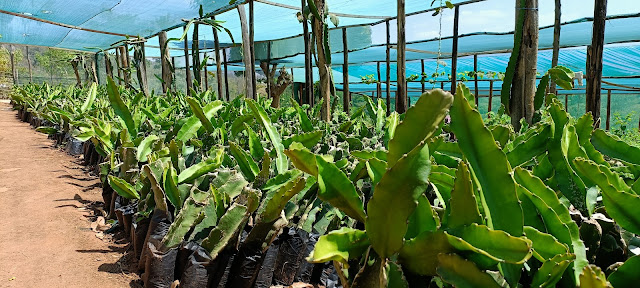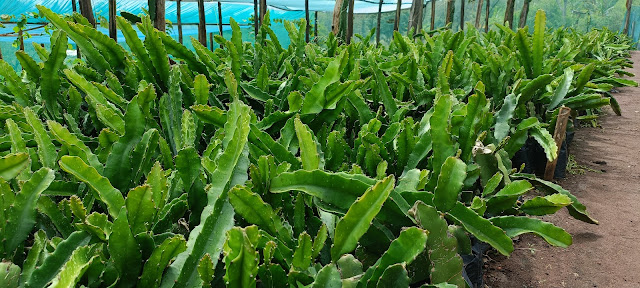Dragon fruits are one of the most expensive fruits on the Kenya shelves today, mainly because dragon fruit farming in Kenya has not been taken up by many. It is a sweet, fleshy and highly nutritious fruit that is eating fresh. Too bad it is still so expensive that most people can't afford it, but we are working so hard to bring the price a little lower to make sure that everyone gets to enjoy the sweetness and health benefits of this great fruit.
 |
| Dragon fruits: Highly nutritious but expensive fruit in Kenya |
The
first time I saw dragon fruits in Kenya, I couldn’t help but remember the
cactus fruits we were enjoying while playing in the semi arid fields of Narok. Back
then, I couldn’t imagine that miles away, in the Asian countries, dragon fruit
farming was a major business. Back home in Kenya, cactus fruits were only considered
as wild fruits, most people oblivious of the health benefits that these fruits
had: maybe it’s the reason why I seldom have to see the doctor…
Now,
dragon fruit farming in Kenya has picked up pace, thanks to the hawk-eyed Kenyan
agri-preneurs who never miss an opportunity.
 |
| Dragon fruits for sale in Kenya |
Price of dragon fruit in Kenya
Currently,
dragon fruits sell at Ksh890 per kg at Zucchini supermarket, making it the
highest priced fruit in Kenya. Can you even compare that with the price of hass
avocado which is at Ksh100 per Kg?
So
this begs the question; why is dragon fruit so expensive in Kenya? Of course
the law of demand and supply plays the biggest role in determining the price. A
huge amount of the dragon fruits consumed in Kenya are imported from Vietnam,
the largest producer in the world so far. So take into consideration the
transport cost, the fact that the fruit is rare and that the demand is higher
than supply and you understand why the fruit sells for close to 1k.
Also read:
3 Reasons Why You Should Invest In Dragon Fruit Farming In Kenya
Nutritional benefits of dragon fruits
Dragon
fruits are also super nutritious; actually, they are considered as a
super-food: those foods that are packed with nutrients.
Let
me shed some light on this…
Dragon
fruit is rich in essential vitamins and minerals but low in calories. It also
contains dietary fiber in generous amounts. If you take a one-cup serving (approximately
230 grams of dragon fruit – typically the average size of one dragon fruit) you
will be giving your body:
- 3 grams of protein
- 29 grams of carbohydrates
- 7 grams of dietary fiber
- 8% of the Recommended Dietary Intake (RDI) of Iron
- 18% of the RDI of Magnesium
- 9% of the RDI of Vitamin C
- 4% of the RDI of Vitamin E
- 136 Calories and zero fats!
Where is dragon fruit farming in Kenya done?
Quite a number of people have called me asking, "Can dragon fruits grow in Kenya?". Well, yes, dragon fruits can grow in Kenya. However, very
few Kenyans have taken up dragon fruit farming. Mugambi and Kinoti, from Meru
are the pioneers of dragon fruits farming in Kenya. The other major dragon
fruit farms are in Naivasha, Makueni and Laikipia.
 |
| Dragon fruit farm in Laikipia, Kenya |
Dragon
fruits would thrive in semi arid areas without much problem. Being of the
cactus family, this fruit does not require a lot of water. Its propagation is
also very easy since new plants are obtained from cuttings of existing ones. However,
obtaining the parent material is what is an impediment to most aspiring
farmers.
Taking
advantage of the fact that dragon fruit seedlings and not easy to come by in
Kenya, the pioneer farmers are charging as high as Ksh2,000 per seedling. This is
what has slowed down dragon fruit farming in Kenya. However, Richfarm Kenya is trying to close the gap by offering affordable dragon fruit cuttings at their Embu nursery.
 |
| Affordable rooted dragon fruit cuttings at Richfarm Kenya |
The future of dragon fruit farming in Kenya
At this point, I would say that dragon fruit farming is the most profitable fruit farming venture in Kenya. One stool of 2 plants can give you about 20 fruits each season. On average, each fruit weighs about 500g. That means each stool will give you approximately 10 kgs every year. If you sell at a wholesale price of 500 per kg, you will be earning Ksh5,000 per stool. One acre accommodates 2,000 stools at a spacing of 1m between the stools and 2m between the lines. That translates to Ksh10 milllion per year from one acre.
It
is obvious that the price of these fruit will come down as more farmers get
into its production. However, that is going to take a while considering that
the price of the seedlings is still above what most farmers can afford and the
fact that the cuttings take a whole year to get to fruiting stage. Kenyans love
quick money and most investors are less likely to wait that long.
Most
parts of Kenya are tropical semi arid zones, ideal for dragon fruit farming.
The market for these fruits, especially in the Asian countries is very high.
Locally, the demand continues to grow as more people become aware of the health
benefits of the fruit.
As
such, dragon fruit farming in Kenya is set to be the next big thing after hass
avocado farming.
We, Richfarm Kenya would love to help you be one of the pioneer farmers of dragon fruits in Kenya. If you would like to be helped in this regard, please get in touch with us on 0724698357.
Affordable Dragon fruit seedlings
We are glad to announce that we have now in stock affordable dragon fruit seedlings at our Embu nursery. Please visit to get yours or call 0723213602 / 0724698357 to order for them.
 |
| Dragon fruit seedlings for sale at Richfarm Kenya |









